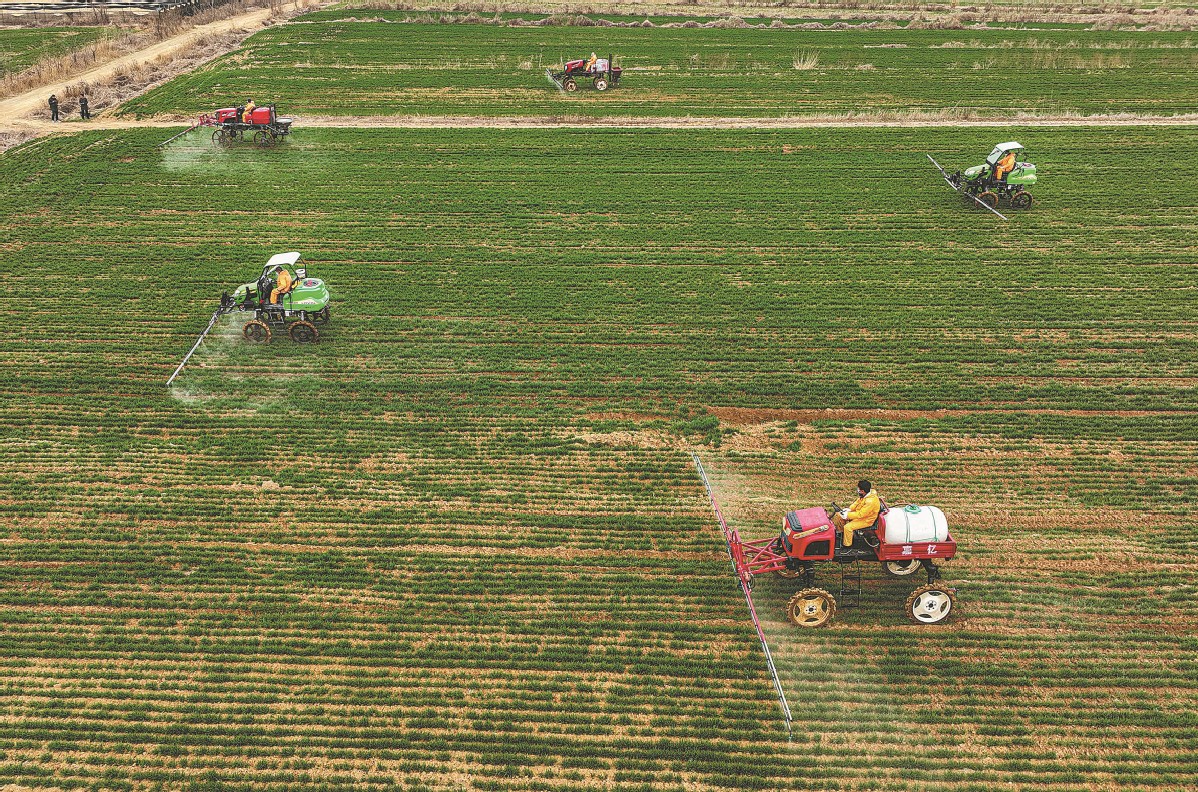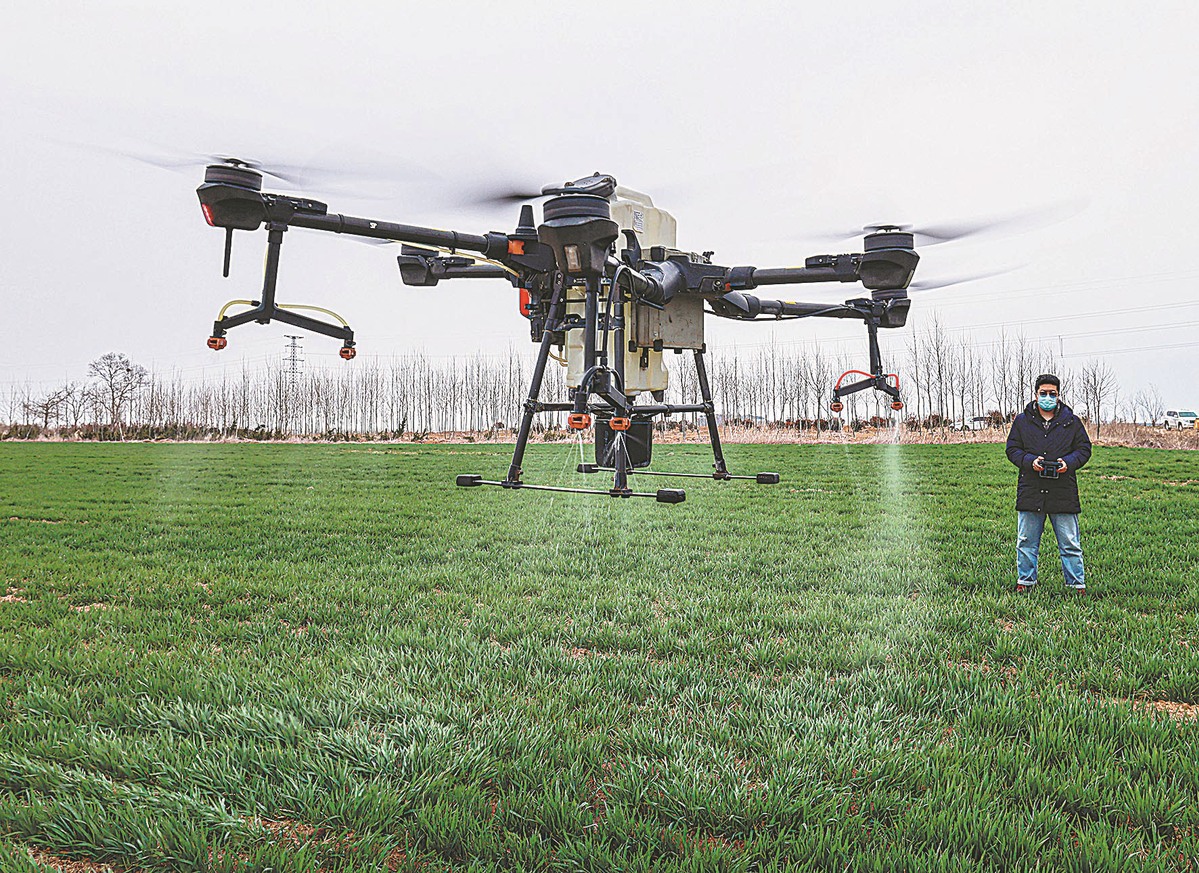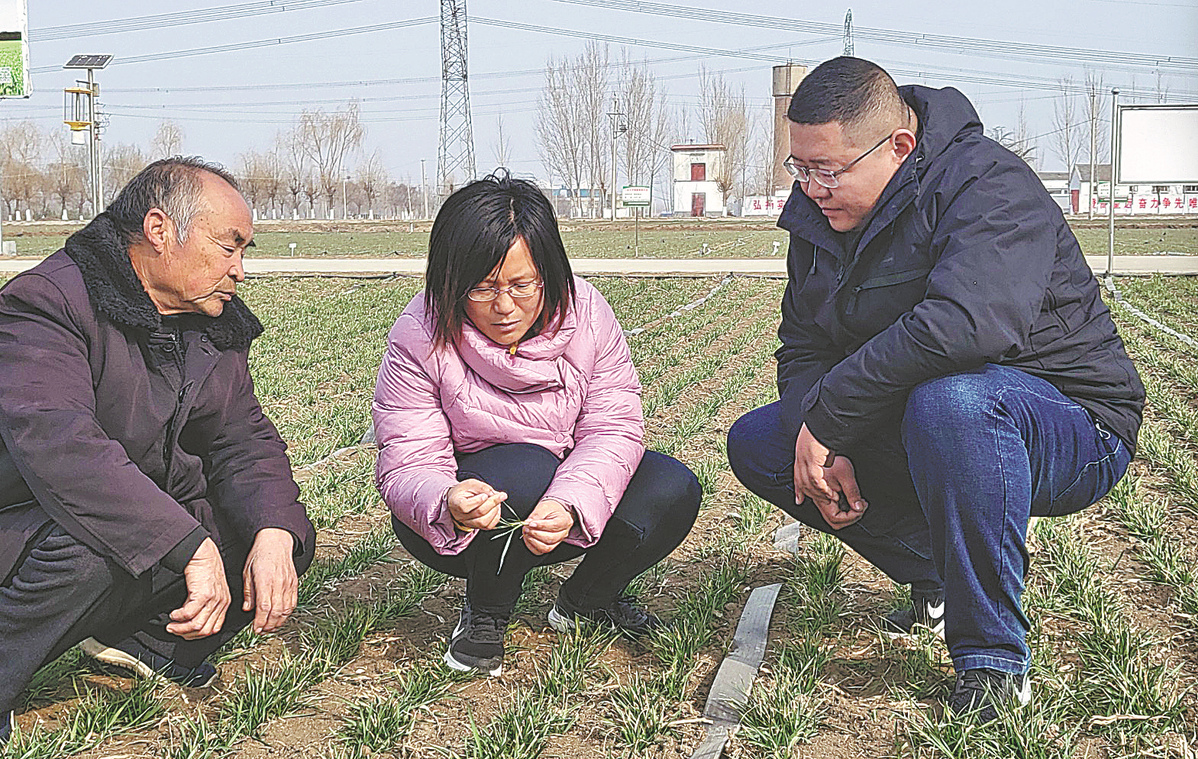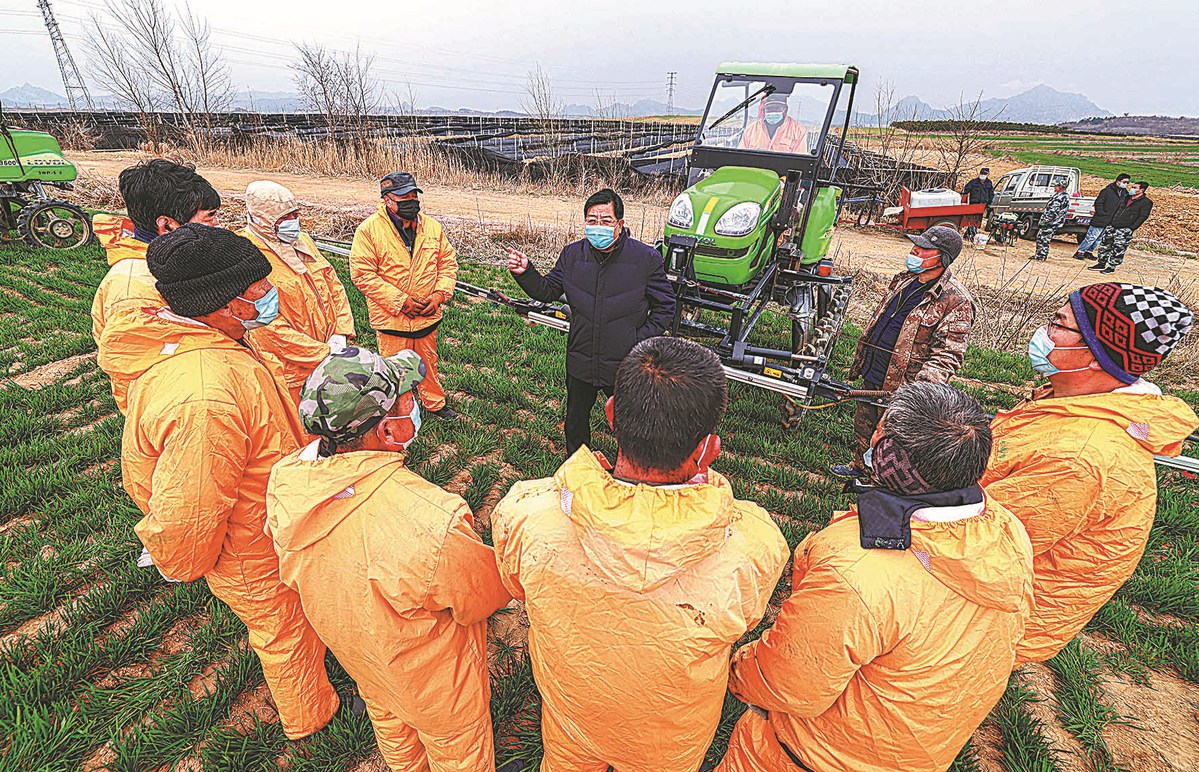
Farmers spread pesticide on wheat fields in Hushan town, Rongcheng, Shandong province. [Photo by Li Xinjun/for China Daily]
Use of automation increases efficiency and crop yields
It was cloudy on Thursday in Mazhuang, a town in the city of Tai'an, which is a major wheat production area in Shandong province. Rain was forecast for the next day.
Xue Lina, who runs an agricultural cooperative in the town, walked through a large expanse of land used to grow wheat, viewing green seedlings swaying in the breeze.
This year has proved tougher for Xue, 39, than previous ones, as she noticed more vulnerable wheat seedlings when the crop started to turn green last month.
"This vulnerability is probably due to late planting as a result of flooding in the autumn," she said, adding the winter wheat planting in the town was delayed for 20 days.
By taking technical instruction, Xue and her colleagues have been quick to offset the impact arising from late planting.
To improve crop nutrition, organic fertilizer must be spread on dozens of hectares of wheat on days when rainfall is likely.
Mechanization is on hand to help, with two of the cooperative's workers using agricultural drones to spread fertilizer over the wheat on Thursday.
"A single drone can spread fertilizer over about 10 hectares of farmland in a day," Xue said, adding that drones spread more evenly than agricultural workers.
Xue is not the only one whose seedlings have been affected by late planting.
Last year, more than 7 million hectares of winter wheat were planted late due to flooding in Hebei, Shanxi, Shandong, Henan and Shaanxi provinces, according to the Ministry of Agriculture and Rural Affairs. This accounts for one-third of the total area of winter wheat planted nationwide last year, posing challenges to this year's summer grain harvest.
Mainly comprising winter wheat, the summer grain harvest is one of the two major harvests in China-the other being autumn grain, which includes corn and mid- and late-season rice.

A drone is used to spread pesticide on fields in Hushan, Rongcheng. [Photo by Li Xinjun/for China Daily]
The summer harvest accounted for one-fifth of China's grain production last year, according to the National Bureau of Statistics.
As the Russia-Ukraine conflict persists, agricultural experts are worried about surging global food prices caused by many factors, including supply chain disruptions in Ukraine and Western sanctions against Russia. The two countries are among the top five wheat exporters, accounting for 29 percent of the global total.
China is strengthening field management for wheat that is planted late, according to this year's Government Work Report delivered by Premier Li Keqiang at the fifth session of the 13th National People's Congress on March 5.
Central and local authorities in major wheat production provinces have made efforts to promote the growth of vulnerable seedlings a key task for spring farmwork.
Since last month, experts have been sent to key wheat production areas by agricultural authorities to help farmers improve the quality of vulnerable seedlings.
Wang Fahong, a member of the team of wheat experts at the Ministry of Agriculture and Rural Affairs, said that thanks to prompt efforts, including technical guidance and the machinery used at almost every stage of wheat growing, most vulnerable seedlings have recovered and are being grown in good conditions.
During the past two months, Wang, 60, who works at the Shandong Academy of Agricultural Sciences, has visited most wheat production areas in Shandong to examine seedlings and soil conditions.
"The conditions for seedlings this year are more complicated. We need to provide different treatment measures according to the conditions of the seedlings and soil," Wang said.
One favorable factor is that temperatures during the winter were higher than in previous years, providing sound conditions for growing wheat, Wang added.

Xue Lina (center), who runs an agricultural cooperative in Mazhuang town, Tai'an, Shandong, inspects wheat crops. [Provided to China Daily]
Work made easier
Agricultural cooperatives and owners of large farms are using machines and smart equipment throughout the entire wheat production process, which has made farmwork more efficient, Wang said.
"For example, plowing machines can penetrate deep into the soil, which is good for root development," Wang added.
The cooperative run by Xue in Mazhuang has 18 workers, who operate on 87 hectares of arable land used to grow wheat and corn.
"About 98 percent of the work related to wheat production, from plowing to harvesting, is done by machines," said Xue, adding that such automation has increased yield substantially.
More than 22 million machines such as tractors, plows and seed sowers, will be used for farmwork this spring, according to the Ministry of Agriculture and Rural Affairs.
In Chongqing, a new type of printer for use specifically by farmers is making planting rice much easier. Instead of using ink, the device spills out rice seeds and groups them into 65-centimeter-wide straw pulp paper backing sheets, which are then laid out in rice paddies ready for the seeds to sprout.
Liang Jinlong, an agronomist at Sinochem Agriculture Holdings, said farmers no longer need to sow seeds manually, but can simply lay these evenly printed seed paper sheets in paddies and cover them with plastic film. Under normal conditions, the seeds sprout and grow, while the straw pulp paper decomposes naturally.
The germination rate is 97 percent, Liang said.
Depending on the user's skill, these machines can print sufficient seed paper to cover 0.13 to 0.20 hectares of land per minute-enough to meet the needs of an entire village. The cost to farmers is about 180 yuan ($28) per hectare.
Yang Xiwen, Party secretary of Xinjian village, Wujian county of Chongqing's Yongchuan district, said, "Compared to manual sowing, seed-printing technology is more precise, saving over 30 percent of seeds and lowering the cost of sowing from 450 yuan per hectare."
The printers ensure a more even distribution of seeds than achieved manually, and prevent overseeding or areas of land that are missed by manual sowing. They also increase the quality and yield of rice, Yang said.
Yu Shenyun, 70, a farmer in Xinjian, said: "Manual seeding is very tiring. It takes more than a day to sow 1 mu (0.07 hectares) of land manually, but with the help of such machinery, this work becomes much easier and can be done in half a day."
In addition to Chongqing, the printers are being used elsewhere, including Jiangsu, Anhui, Jiangxi, Hubei, Hunan and Sichuan provinces.

An agricultural technician introduces field management techniques to workers operating machines in Hushan. [Photo by Li Xinjun/for China Daily]
Different varieties
According to soil conditions, Xue chooses several varieties of wheat seeds for use on the dozens of hectares of land she manages.
In 2019, she started to manage a 5-hectare wheat field with poor soil conditions. After using machinery on the land, including a deep plow and soil press, she chose a type of wheat seed that can produce several ears.
"For the past three years, the average yield from the 5 hectares has been 600 kilograms per 0.07 hectares-100 kg more than before," Xue said.
For most of the land she manages that is used to grow wheat, Xue uses Jimai 22, a variety of seed developed by the Shandong Academy of Agricultural Sciences.
"These seeds are resistant to disease and adaptable to different environments, making for a high and stable yield," Xue said.
Liu Jianjun, a researcher who has been developing wheat seeds for more than three decades at the Shandong academy, said Chinese experts have developed a wide range of wheat seed varieties, including those that can produce strong flour, also known as bread flour, and purple color wheat flour, known as nutrition flour.
"We are also developing seeds to produce types of flour that can meet customers' different demands," Liu said.
"Our country attaches great importance to grain production, and I am confident about planting grain by using new knowledge and techniques," said Xue, who graduated from China Agricultural University.
Category
Latest Methods Play Vital Role in Spring Farmwork
Contributor
Latest Methods Play Vital Role in Spring Farmwork
Country
Story

